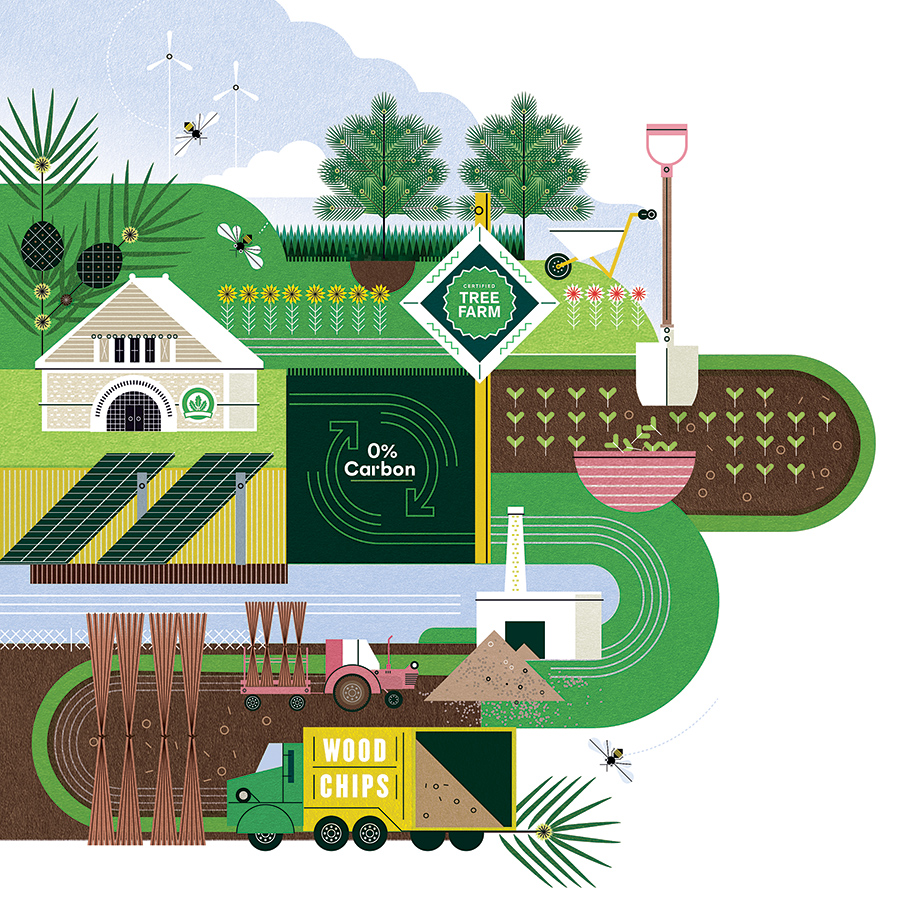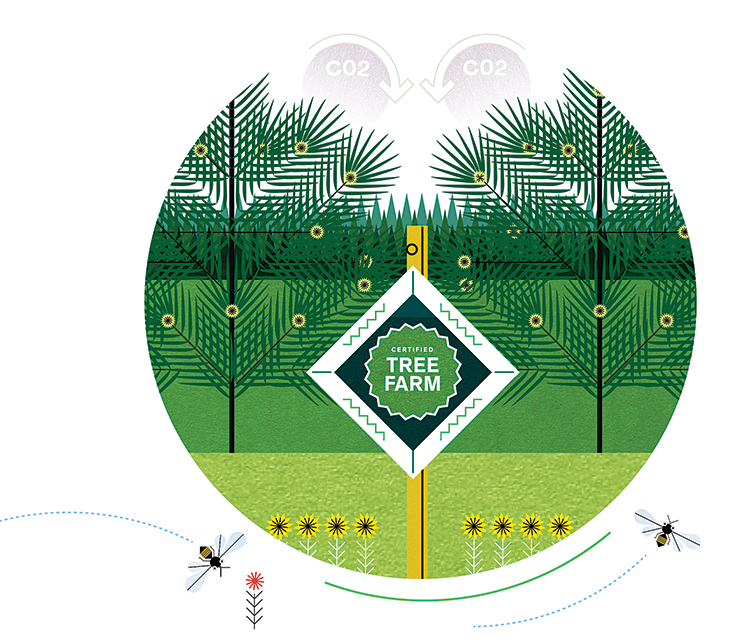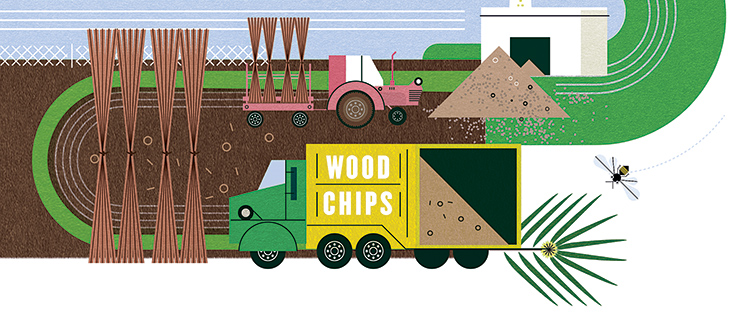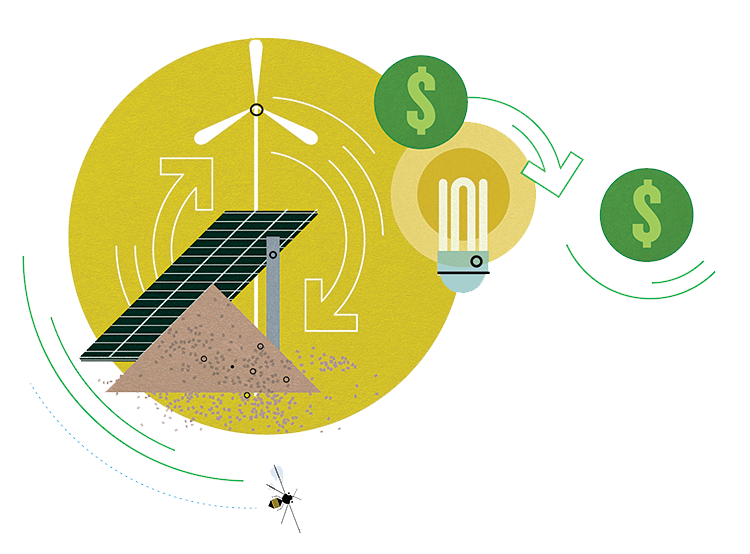Illustrations by Sally Caulwell – Folio Art
What started with a pledge a decade ago turned into a movement. That movement, and every step forward for the past 10 years, resulted in Colgate becoming the first carbon neutral campus in New York State.
The Sustainability Council — made up of faculty, staff, and students — had a clear charge to advance sustainability and to guide Colgate toward a future of zero net carbon emissions on campus.
The University hired John Pumilio as its first director of sustainability, and work began in earnest to find new initiatives that would help push Colgate toward its goal. It wouldn’t be easy, and the pathway to carbon neutrality was not without its curves.
These are the milestones that helped the University make its mark.
Milestones
- Colgate’s first Environmental Council (later renamed the Sustainability Council) forms.
- President Rebecca Chopp takes action on the recommendation of the Sustainability Council and commits Colgate to carbon neutrality by signing the American College and University Presidents’ Climate Commitment (since renamed Second Nature’s Carbon Commitment).
- The University hires its first director of sustainability, John Pumilio.
First campus carbon footprint: 17,353 tons
- The Colgate Community Garden breaks ground, helping to source more local food for Colgate’s dining halls. By supporting locally produced food, Colgate reduces emissions associated with transportation.
Campus carbon footprint: 15,463 tons
- First Sustainability and Climate Action Plan released
- First LEED Gold Certified building: Trudy Fitness Center
Campus carbon footprint: 16,194 tons
- Colgate enters into a carbon-offset and educational program with Patagonia Sur. In Chile’s Aysen Region of Patagonia, the University finances the planting of native trees that remove carbon from the atmosphere and help offset the University’s carbon footprint. Research trips to the area enable students and professors to study forest regeneration and conservation efforts.
Campus carbon footprint: 10,711 tons
- A solar thermal array is installed at 100 Broad Street residence hall.
- First forest carbon inventory is completed to determine how much carbon is sequestered.
1,578 tons of CO2 annually - Carbon sequestration = Carbon dioxide removed from the atmosphere and stored (in this case by trees)
Campus carbon footprint: 6,244 tons
- Colgate earns American Tree Farm System certification for long-term sustainable forest management.
Campus carbon footprint: 6,962 tons
- Green Building Standards are approved and incorporated into the campus’s overarching Building Design and Construction Standards.
Campus carbon footprint: 9,562 tons
- First geothermal heating and cooling project is installed in Chapel House
Campus carbon footprint: 10,358 tons
- Colgate harvests willow from a 7.5-acre plot planted in 2009. Over a 20-year period, this plot will yield approximately 900 dry tons of biomass for the University’s woodchip burning facility.
- Green Revolving Loan Fund is established (see story below)
Campus carbon footprint: 8,175 tons
- Upgrades to biomass boiler in the heating facility allow the University to rely less on fossil fuel and more on renewable and carbon neutral wood chips.
Campus carbon footprint: 4,290 tons
- Colgate has reduced its on-campus carbon footprint by more than 46 percent since 2009.
Campus carbon footprint: 0 tons; carbon neutrality reached
Offset projects bolster sustainability domestically and internationally
Work must continue to reduce Colgate’s campus carbon footprint. For every ton of carbon emitted on campus, the University must purchase an equal amount of offsets on carbon reduction projects off campus. At the same time, efforts on campus must continue to draw down that annual output in order to reduce reliance on annual offsets.
To mitigate remaining University emissions for air and automotive travel and energy consumption related to buildings, Colgate has invested approximately $60,000 in the following new offset projects. A working group of the University’s Sustainability Council evaluated these projects based on their effectiveness, social and ecological benefits, cost, and learning opportunities for students.
Seneca Meadows landfill gas to energy (New York)
Supported by NativeEnergy, this project helps to fund a methane capture system for 413 landfill gas extraction wells to generate 18 megawatts of electricity (enough to power 20,000 homes). The project also protects a wetlands preserve that is home to more than 215 species of birds.
May Ranch Avoided Grassland Conversion (Colorado)
This carbon sequestration and conservation project protects approximately 14,500 acres of grasslands in Prowers County, Colo. This preservation helps to prevent the release of carbon sequestered in soils while also serving to protect one of the most endangered ecosystems in the country.
Rimba Raya Biodiversity Reserve (Indonesia)
With the development of palm oil plantations threatening endangered Borneo orangutan, and the potential destruction of carbon-dense tropical peat swamps, this U.N.-supported project, by Natural Capital Partners, shields approximately 160,000 acres of forest from development for oil production.
Danjiang River Solar Cookers (China)
This project aims to reduce coal consumption, and the resulting carbon emissions, by installing solar cookers in nearly 100,000 households. Solar cookers also help to reduce air pollution and related respiratory diseases stemming from burning coal.
Renewable Energy Certificates (United States)
Colgate has purchased renewable energy certificates (RECs) from the Greenlight Energy Group, the first U.S. female-owned renewable energy marketing company. Colgate’s purchase of Green-e certified RECs means that 100 percent of the University’s electricity is supplied from renewable energy that meets the highest environmental benefits.
The Big Picture
Beyond carbon reduction, Colgate is advancing environmental and social sustainability in general. “Carbon is part of it, but we don’t ever want to lose sight of the larger goal of trying to create a more sustainable society,” Pumilio says.
Some of the University’s efforts last year included:
 The community garden for campus and the community. Approximately 1,600 pounds were donated to the Hamilton Food Cupboard.
The community garden for campus and the community. Approximately 1,600 pounds were donated to the Hamilton Food Cupboard.
Water use
- 21,859 gallons of water per student
- 6.2% reduction since 2010
Total waste
More than 20 tons (the same weight as about 12 Priuses) has been reduced since 2017 through ramped-up recycling efforts and waste reduction in the dining facilities.
Electricity use
- 30k megawatt-hour
- 5% reduction since 2009 (enough to power approximately 150 homes for a year)
When talking about sustainability efforts, the work is never done. In addition to furthering these efforts, the focus for the near future is on Colgate’s energy use and buildings.
Pumilio has developed a strategic approach to measuring and managing the University’s power and energy use. All of the buildings are properly metered and provide continuous feedback. “We are getting to a place where we know in real time if there’s a problem in the building — if it’s underperforming or malfunctioning,” he explains. Then teams can go in, with precision, and fix the inefficiencies or malfunctions with the energy system. This not only saves energy and reduces carbon, but also makes the space healthier and more comfortable. The next phase, now that data has been collected, is setting energy goals.
Also, as Colgate builds new structures in the years ahead, they will meet LEED Silver certification or better, according to the University’s green building standards. “Benton Hall is a wonderful example,” Pumilio says. “We had to meet these core institutional needs, but we also designed and built that building with energy and sustainability in mind. We just got our measurement and verification data back, and the building is even outperforming what we thought it would do.”
Over the years, this endeavor has been educational for everyone, President Brian W. Casey said in a WAMC radio interview on Earth Day. “What I think we’ve all learned is that there’s not a single straight line toward achieving a goal,” he said. “Instead, it’s a lot of different efforts, lots of adjustments.
It’s easy to get frustrated [but] you just have to say to yourself, ‘This is a joyful thing for the University to accomplish, and we’re going to get there the best way we can.’”
Revolving Dollars
When the term “investment” is mentioned, light bulbs, woodchips, and boilers don’t typically come to mind. But these items are delivering cost and energy savings at Colgate — thanks to the Green Revolving Loan Fund (GRLF).
Often explained in the sustainability world as funds that “transform expenses into investments,” GRLFs turn upgrades into opportunities and projects into profits.
“Colgate’s GRLF is an internal fund earmarked for energy efficiency, renewable energy, and other sustainability projects that generate cost savings over time while reducing carbon and ecological footprints,” Pumilio explains. “Savings are tracked and reinvested into the fund to finance the next round of green investments.”
Colgate’s GRLF was created in 2018 with $1.25 million and has financed three official projects so far. Colgate’s first official GRLF project was two major performance upgrades to an existing biomass boiler system. Financed by the GRLF for $400,000, it is estimated that the recently completed project will reduce the cost of woodchips needed to heat the campus by approximately $22 per ton, for an annual savings of approximately $198,000. Combine these savings with others delivered by the upgrades and this project is expected to pay for itself in just 1.8 years. Even better, 100 percent of these savings will be returned to the GRLF until 120 percent of the initial project cost has been restored.
“If invested responsibly, the fund keeps financing projects over and over again as it grows over time,” Pumilio says. “This ensures Colgate will always have the resources it needs to implement projects that will have a positive environmental impact.” — Sara Furlong
The Class of 1970 has chosen to support this fund as part of its 50th Reunion next year.




